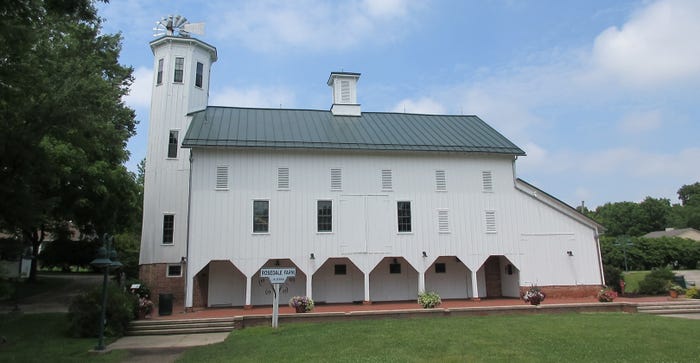August 7, 2019

The Everal homestead was established in the early 1870s. In 1914 it was named Rosedale. The brick farmhouse and many outbuildings on the property are a well-preserved representation of a well-to-do family home of the period. It has become Heritage Park in Westerville, Ohio.
Home of prosperous tile maker
John W. Everal established the Everal Tile Co. of Westerville in 1876 on the banks of Alum Creek, after discovering a deposit of clay that would produce a glasslike tile used to drain farmland. His very successful company grew rapidly until 1912, when the deposit of clay was depleted. The company also produced bricks used in many of the town’s buildings, as Westerville continued to grow. After the depletion of the clay deposit, the company was relocated to Schrock’s Ford on Alum Creek and run by John’s son F.H. Everal until 1929.
The company flourished, as did the homestead. The brick two-story farmhouse, with wings to either side of the main house, has two covered porches with beautifully carved trim gracing the two entrances. The house was updated and added onto over the next century, providing a stately place to entertain.
Milk sold to village residents
The outbuildings were as well-built as the main house and provided for the needs of the Everal family’s everyday living. The henhouse produced eggs and chickens daily for the family table. The milk house was built close to the road for the convenience of selling and delivering milk to people in the village. Large cans of milk were set in a concrete trough and cooled with cold spring water. The milk house also had an area for the cleaning and storing of returned milk cans.
2-story carriage house
The carriage house is a two-story affair, sitting between the house and the barn. It served two purposes. Built into the side of a hill, the upper story sheltered the family carriage. It also served as a place to store tools and a work space to maintain the carriage. The basement opens out on the opposite side at the bottom of the hill and was used for butchering.
After the butchering was done, the meat was taken to the smokehouse. With no refrigeration, the only way to preserve the meat for winter was to salt-cure or smoke the meat for two to three weeks — effectively preserving it for long periods of time.
Last, but not least, of the outbuildings is the outhouse. It is situated out back, about 50 feet to 100 feet from the house. It is small, approximately 8 feet by 8 feet, and sits over a pit. There is no heat, light, ventilation or running water.
Bank barn with octagon tower
The unique Carpenter Gothic-style barn was added to the homestead in 1896. It was a true bank barn, built into the natural topography along Alum Creek. The basement at ground level housed horses and cattle. The mow floor was accessed on the opposite side of the barn by the natural grade of the hill, and it was used for machinery and storage. The third level, the loft, was hay storage. Hay was delivered to the basement by way of a hay chute to feed the livestock.
The barn’s most unique feature is the octagon tower on the south end of the barn that is topped with a windmill. It is most often mistaken for a silo, but the tower actually houses a spiral staircase. At the top of the tower was a 1,000-gallon water tank. The windmill above powered a water pump to lift water from the well to be stored in the water tank. Then, gravity fed the water tanks in the basement as needed for the livestock. The windmill was made by Sears, Roebuck and Co. and purchased for $19.95 in 1902.
History park for community
In 1992, the city of Westerville acquired the land and the buildings. The unique barn was to become a community center. In 1999, the Everal Barn was moved 40 feet to make way for the widening of Cleveland Avenue and to protect the historic structure for the future. It was placed on a new poured foundation and faced with the brick from the original foundation. With all the changes and repairs complete, Heritage Park was officially opened in July 2000.
Since then, the beautiful 52-acre historic park has been a favorite of residents of Westerville and surrounding communities. Early local history can be explored by strolling along the self-guided walking tour. The Everal Barn is now an event space available for meetings, weddings, reunions, etc., To learn more about the barn, visit westerville.org. Being listed on the National Register of Historic Places helps to ensure the heritage of Westerville will be preserved for future generations to learn of the past and enjoy for years to come.
Gray writes from Mount Vernon, Ohio. Contact her at [email protected] or 740-263-1369.
About the Author(s)
You May Also Like




